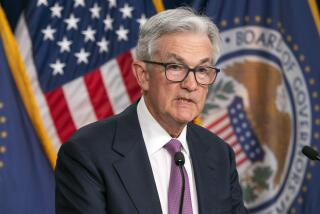Cooling Off--Heading for Permafrost? : UCLA’s new economic forecast sees danger to California in any further interest rate hikes
Be it Mother Nature, the end of the Cold War, the Federal Reserve or jittery currency traders, forces well beyond the control of Californians are conspiring against a smooth economic recovery for the state.
First there was the devastating Northridge earthquake, then continuing defense cuts and rising interest rates and now an unexpectedly vulnerable U.S. dollar on foreign exchanges.
The dollar’s startling plunge this week reignited inflation fears and is generating new uncertainty about interest rates. Rising rates already have weakened California’s fledgling recovery, according to the latest report by the UCLA Business Forecasting Project. Mortgages and other loans have become more costly since February, a period in which the Fed raised short-term interest rates four times. (The Times opposed the last increase.)
The Fed’s preemptive strikes to head off inflation and to cool growth nationwide by raising rates have had the unintended consequence of retarding California’s recovery. The higher rates depressed residential building in the state during the first quarter of 1994, according to UCLA. Home sales have suffered. Earthquake rebuilding is behind.
Despite California’s slowness to move out of recession, the nation will have a “very good year” with inflation in check, according to UCLA. Fed Chairman Alan Greenspan echoed the forecast, declaring that the outlook for the economy “is as bright as it has been in decades” and that inflationary pressure is negligible.
However, he refused this week to answer questions about the dollar, which plunged through the key psychological barrier of 100 yen briefly Tuesday amid the lack of overt action by U.S. monetary authorities to defend the currency. Greenspan would say only that he and Treasury Secretary Lloyd Bentsen “have been following developments very closely because we cannot be indifferent to major movements in our currency.” The comments helped to quell unsettled financial markets, and the dollar, though still volatile, has recovered a bit.
Unless the dollar stabilizes, the Fed will be under pressure to raise rates again when its policy-making Open Market Committee meets early next month. There is little evidence otherwise of the need for another rate boost. The Fed’s new beige book of regional economic activity reported more moderate economic expansion, with growth crimped in some areas because of higher mortgage rates. The interest rate hikes apparently have worked to slow down the economy.
The dilemma posed by the dollar aptly demonstrates a potential downside of global financial markets to the U.S. economy. A world economy offers immense opportunities, but the adjustments can be jarring--seemingly beyond U.S. control and certainly beyond California’s.
More to Read
Inside the business of entertainment
The Wide Shot brings you news, analysis and insights on everything from streaming wars to production — and what it all means for the future.
You may occasionally receive promotional content from the Los Angeles Times.










